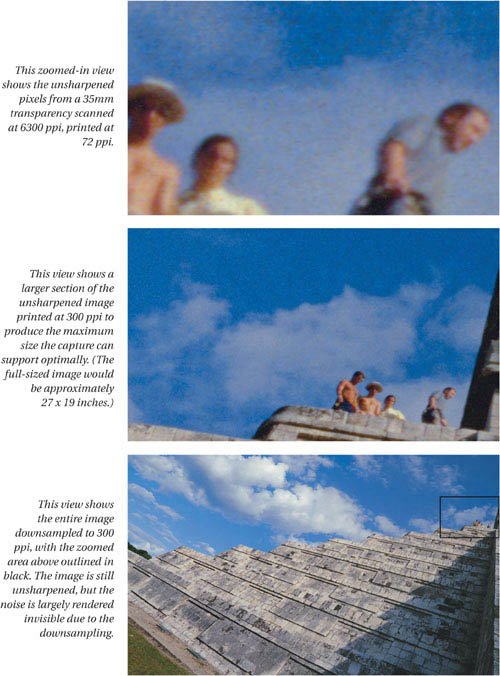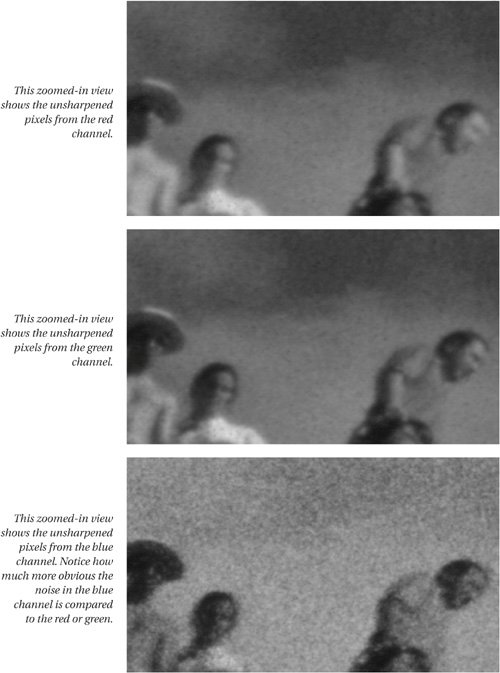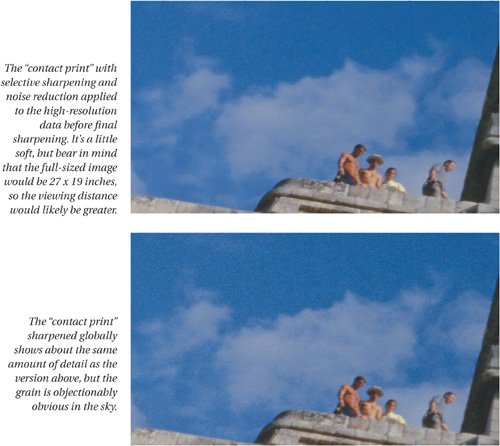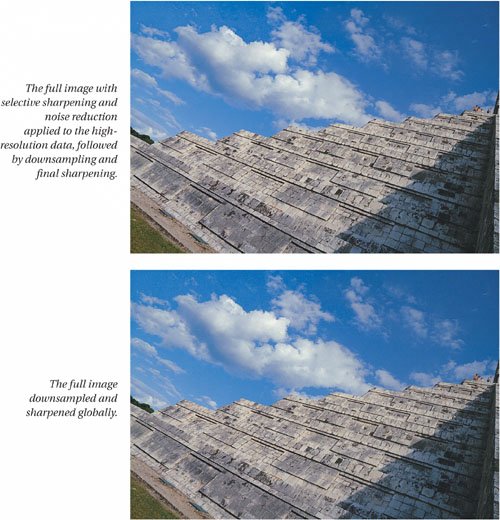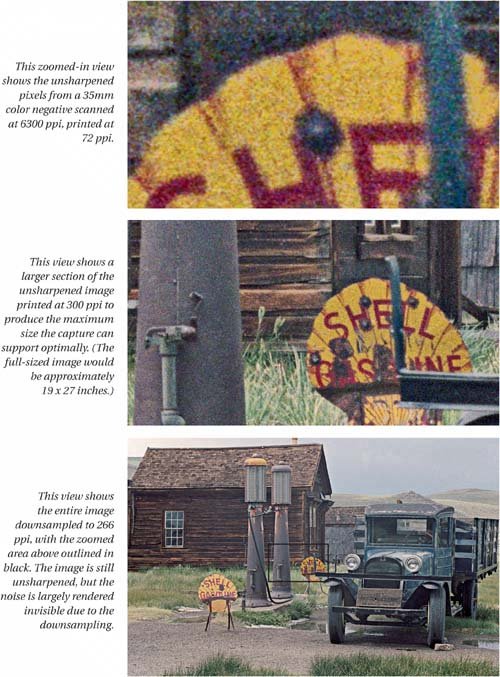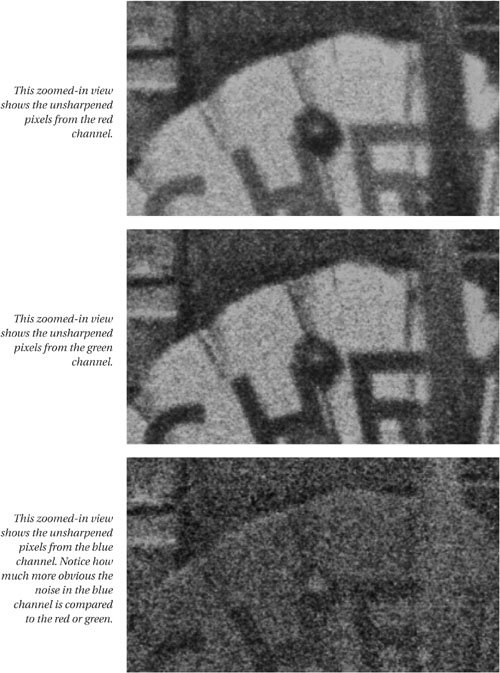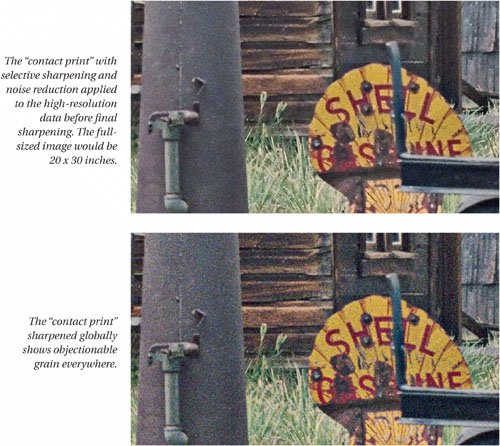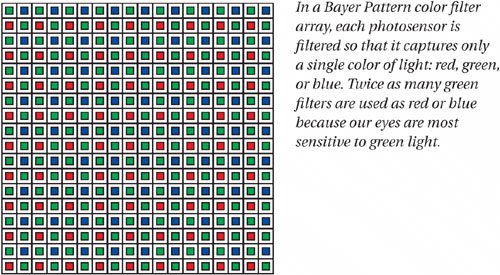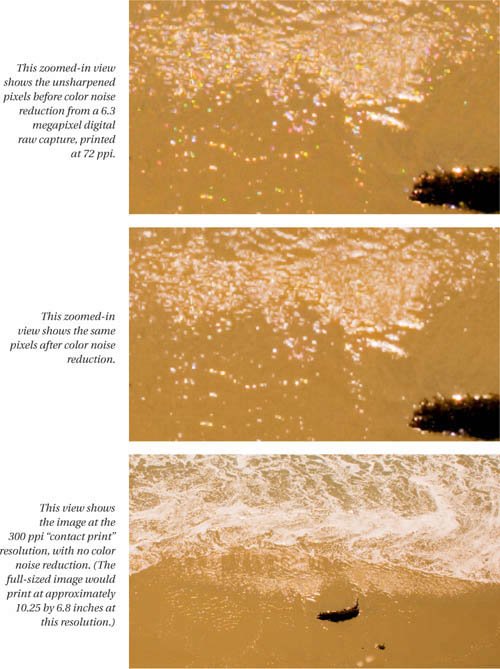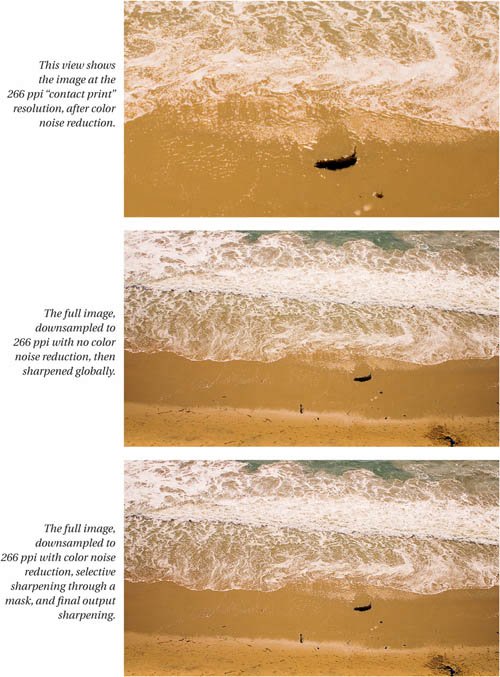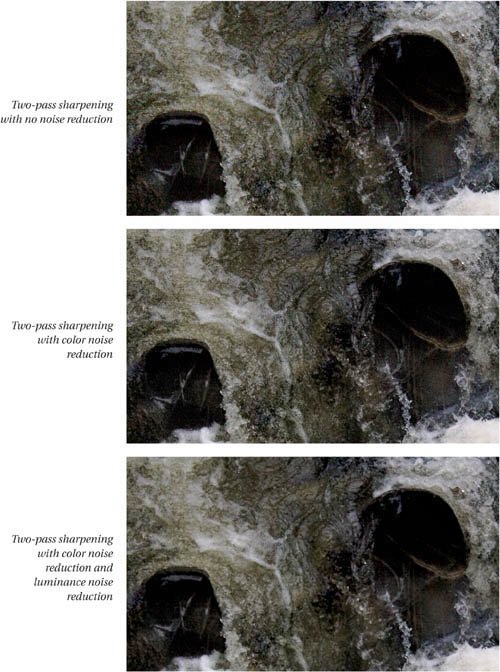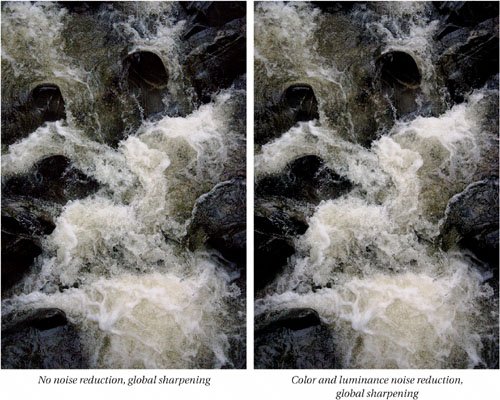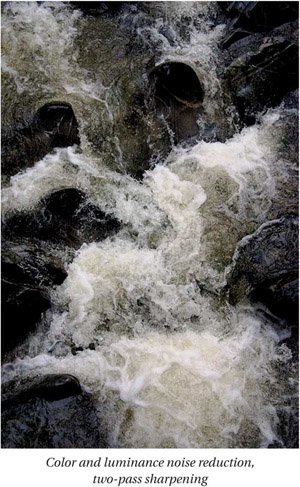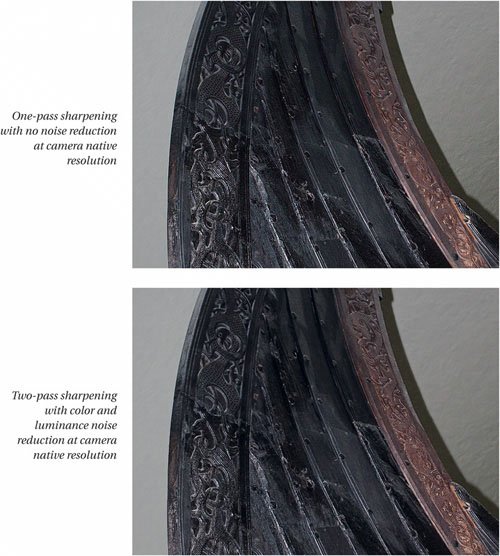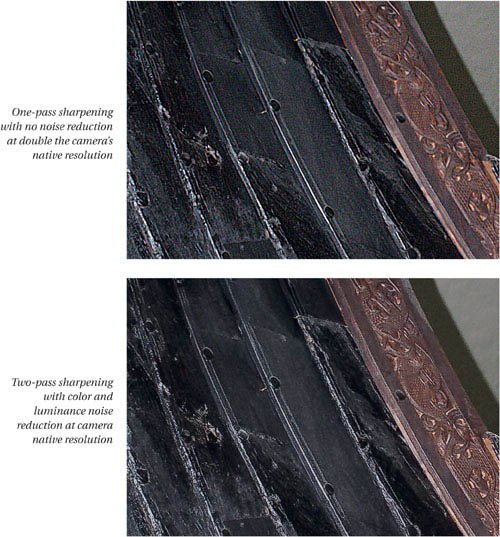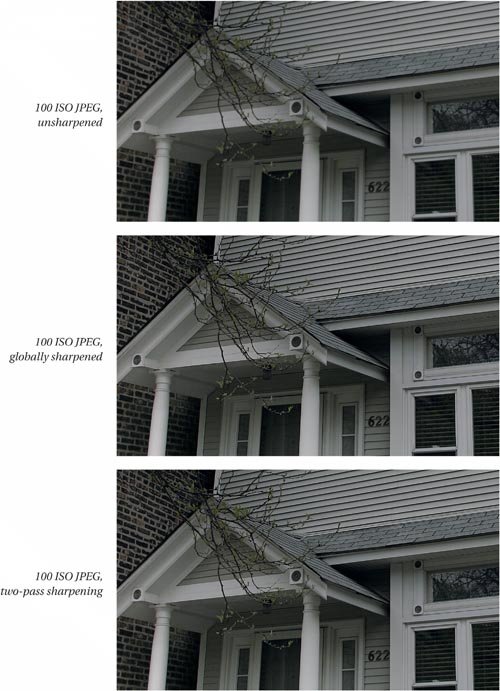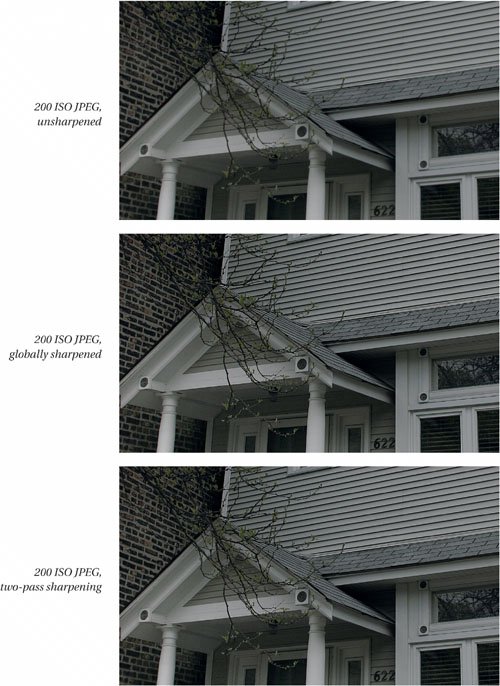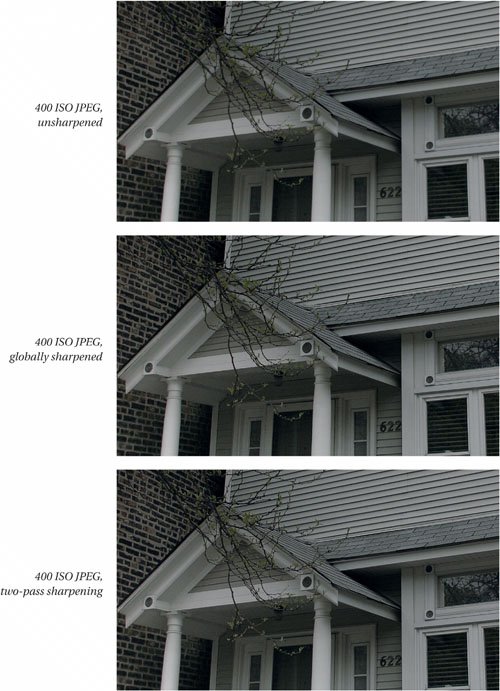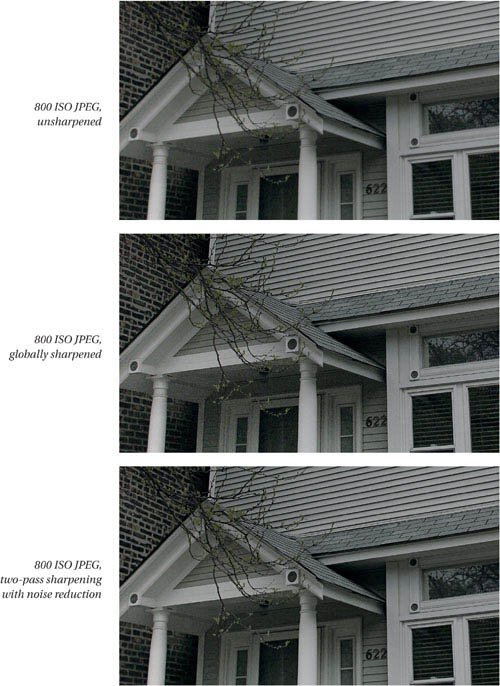Image Sources
| The image source imposes its own signature and its own limitation on the image. The signature is the relationship between the noise that we want to de-emphasize, and the detail that we want to emphasize. The limitations are the degree to which the image can be enlarged, and the smallest details that can be captured. In part, enlargement is limited by the gross pixel count, especially with digital captures, but the noise signature also plays a rolewe typically scan film to obtain a significantly higher pixel count than digital captures offer, yet film scans cannot withstand as much enlargement as a digital capture of equivalent pixel dimensions. The reason is that digital captures generally have less "noise" than scanned film, because the interaction between the film grain and the scanner's pixel grid exaggerates the grain to produce a noise signature stronger than the digital noise from digital cameras. A great deal more heat than light has been generated in discussions of the equivalent information content of digital and film captures. Without adding too much fuel to the fire, my experience tells me that 35mm film scanned at 6300 ppi (creating a file approximately 8900 by 5700 pixels) has about the same potential for enlargement as a digital capture in the 68 megapixel range (approximately 30003500 by 20002350 pixels). This is a very approximate rule of thumb. Detail, Film Grain, and Scanner NoiseThe first sharpening challenge lies in emphasizing detail without emphasizing noise. We can often accomplish this by simply protecting the noisy areas from sharpening. In more extreme cases, we may need to apply some noise reduction prior to sharpening. (I'll discuss specific techniques for doing both in Chapter 4, Sharpening Tools and Techniques.) Much depends on the final use of the image. Downsampling can hide a great deal of noise, making the image easier to sharpen, so for one-off uses at sizes that are small enough to allow downsampling by 50% or more, noise may be less of a concern. But as we approach the practical size limitations of the capture, the noise becomes ever-more obvious and may need special handling. Scanned transparencies, scanned negatives, and digital captures all have their own noise characteristics. They share the property that noise increases with higher ISO ratings, but they differ in important ways too. First, let's look at scanned film. Transparency Film GrainThe grain in scanned film becomes visually obvious at scanning resolutions far below that required to resolve individual grains. (Resolving individual grains would require scanning at ridiculously high resolutions of around 11,000 ppi, providing no more usable image information than a lower-resolution scan.) Grain is most obvious in small formats like 35mm, and much less obvious in medium- or large-format transparencies. However, much of the image noise comes not from the grain itself, but from the interaction of the grain, the scanner's sampling grid, and any digital noise introduced by the scanner. The grain in color transparencies tends to be monochromatic, but the scanner noise is typically strongest in the blue channel, since the blue filter is the least efficient in terms of allowing light to pass through. As a result, transparency grain often shows up at its strongest in clear blue skies, though close examination of the pixels shows that the grain is present in the other channels, albeit to a lesser extent. Figure 2-1 shows three views of typical scanned transparency noise. Figure 2-1. Noise in scanned transparencies
Figure 2-1 also shows the individual color channels at the same Actual Pixels view as the first illustration. It shows how dramatically noisier the blue channel is than the red or green. The purpose of the figure is to convey an impression of typical grain in a transparency scan, and to show its diminishing influence as we reduce the image size. Figure 2-2 shows optimal and less-than-optimal sharpening for the image at "contact print" resolution, and at the downsampled resolution required to fit the image to the page. The optimally sharp versions were created by applying preliminary sharpening and noise reduction selectively using layer masks to isolate the edges, then applying global sharpening tuned to the halftone printing process. Figure 2-2. Optimal and less-optimal sharpening
In the case of the downsampled image, the preliminary sharpening and noise reduction for the optimally sharpened version were performed on the full-resolution 6,300 ppi capture, then the image was downsampled to 300 ppi and sharpened for the halftone process. The other version was simply downsampled to 300 ppi, then sharpened globally. The differences between the two are much more subtle on the down-sampled version than they are in the "contact print," reinforcing the point that the final output size makes a big difference, but the globally sharpened version shows some shifts in both tone and hue that are absent in the optimally sharpened version, and the clouds appear a tad crunchy. Color Negative Film GrainGrain is typically much more obvious in scanned color negative than in scanned transparencies. It's not that color negative is inherently grainier than transparency. Color negatives record a wide dynamic range from the scene and compress it into a narrow dynamic range on film, and when we scan, we expand that narrow dynamic range recorded on the film. In so doing, we exaggerate the grain more than we do with color transparencies. As with color transparency, the noise is a product of the film grain, the scanner's sampling grid, and the noise introduced by the scanner, but the noise signature is noticably different from that of transparency film. Noise in color negatives manifests itself as color noise rather than monochromatic noise, and so demands a different treatment. Moreover, while the degree to which we have to address grain separately from sharpening depends on the enlargement factor needed, just as it does with transparency film, color negative requires more aggressive treatment, and requires it at lower enlargement factors than transparency. Figure 2-3 shows the typical noise before sharpening from a color negative scanned at 6300 ppi, using the same views as Figure 2-1: Figure 2-3. Noise in scanned color negative
The extreme downsampling to 300 ppi in the bottom image mitigates the grain by downsampling it almost out of existence. But the "contact print" view shows that grain in color negative scans is stronger and a bigger problem than that in transparency scans, and hence requires special handling at lower magnification factors than color transparencies. As a result, traditional prepress has generally shunned color negatives in favor of transparencies, no matter which film format. Reproducing images from 35mm color negative is certainly challenging, but it's by no means impossible to produce good results even from 35mm. Shooting larger format film reduces the grain problem by reducing the enlargement factor, which is the reason prepress has generally preferred the larger formats. Figure 2-4 shows the actual pixels from the individual channels. Again, the blue channel is the noisiest of the three due to the physics of the scanner, but the color negative shows more noise in the green and blue channels than does the transparency. Figure 2-4. Channel noise in scanned color negatives
Figure 2-5 shows the two versions of the "contact print" and the complete image. The first version of each has had noise reduction and selective sharpening applied through masks, followed by a second round of sharpening tailored to the output process. The second version of each has been sharpened globally at the final output resolution. Figure 2-5. Optimal and less-optimal sharpening
With the color negative, the difference between the two versions is more obvious than with the transparency example, even in the downsampled version. The sky is grainier, and the license plate is more difficult to read, in the globally sharpened version than in the version that had noise reduction and sharpening applied to the high-resolution data prior to down-sampling. So clearly grain is a more pressing concern with color negative than with transparency, though it again varies with enlargement factor. Detail, Noise, and Digital CaptureNoise in digital captures differs from the noise in scanned film in several important ways. But before examining the differences in detail, we should point out that several different technologies get lumped into the general category of "digital camera," each with its own properties. The vast majority of digital cameras, whether point-and-shoot or digital SLRs, are color filter array (CFA) cameras. In a CFA camera, each photosite on the sensor is covered by a color filter and contributes a single pixel to one color channel. The "missing" color information is then interpolated from the neighboring pixels in a process known as demosaicing. Figure 2-6 shows a typical Bayer-pattern color filter array. Figure 2-6. A typical color filter array
When you shoot JPEG or TIFF, the demosaicing is performed in the camera using the camera vendor's proprietary routines. When you shoot Raw, the demosaicing is done by the raw converter, which typically offers more control. Demosaicing is a complex process that inevitably involves a trade-off between localized contrast (which looks a lot like sharpening), and antialiasing (which looks like blurring), to prevent artifacts that arise when a detail in the image falls on only one color of pixel. Many cameras include an optical low-pass filter to reduce artifacts, but the raw converter, whether in the camera or in post-capture software, performs a significant role, so one raw converter's output with "no sharpening" may appear sharper than another raw converter also set to no sharpening. Similarly, while most raw converters offer some noise reduction, the actual results may differ. Cameras that shoot JPEG present an additional issuethe nature of JPEG compression creates 8 by 8-pixel blocks that can become visually obvious after editing, or even, at high ISO ratings, before editing. So the challenges presented by digital CFA cameras are quite different from those posed by scanned film. CFA cameras are prone to two distinct types of noise: color noise and luminance noise. Color NoiseAll CFA cameras suffer from color noise to a greater or lesser degreeit's an inevitable byproduct of demosaicing. Color noise can raise its head anywhere: it's largely independent of ISO speed or exposure settings, and it can appear in highlights, shadows, or midtones. It does, however, vary from camera to camera. Most raw converters do a good job of eliminating color noise, so much so that many shooters use a "set-and-forget" approach, dialing in a default color noise reduction setting for each camera. Color noise in JPEGs can be more problematic. The in-camera conversion doesn't always do a good job of eliminating color noise, and the JPEG compression process tends to accentuate any color noise that isn't eliminated in the in-camera conversion. Luminance NoiseUnlike color noise, luminance noise varies both with ISO speed and with exposure. Underexposed digital captures are much more prone to noise, particularly in the shadows, than are underexposed film captures, so it's quite possible that a well-exposed ISO 1600 digital capture may be less noisy than an underexposed ISO 100 digital capture. Some raw converters, particularly those from the camera vendors, have a tendency to bury shadow noise by simply clipping shadows to black, but it's usually worthwhile addressing luminance noise in the raw converter when you shoot raw. At very high ISO speeds, however, a dedicated third-party noise-removal tool may be needed to get the best rendering. Luminance noise in high-ISO JPEGs should always be addressed before sharpening, and any remaining noise should be protected from sharpening, otherwise it will simply become more obvious. I'll discuss specific techniques for doing so in Chapter 4, Sharpening Tools and Techniques. Color Noise ExampleFigure 2-7 shows color noise from a digital raw capture made at ISO 100, with good exposure. This image has no significant luminance noise, so this example focusses exclusively on color noise. Figure 2-7. Color noise in a digital raw capture
At Actual Pixels and contact print zoom levels, the color noise is visually obvious. On the full-sized downsampled image, the color noise is still there if you look for it, but the bigger difference is between the global sharpening and the more nuanced multipass sharpening, which produces much better midtone contrast. We'll return to this topic later, but first let's look at some images where noise is a more significant problem. Noise and ExposureFigure 2-8 shows Actual Pixels view of a significantly underexposed (-2 stops) raw capture shot at ISO 100. It suffers from much more noise than the ISO 100 image shown in Figure 2-7 because of the underexposure. Where noise reduction was desirable in the image in Figure 2-7, it's essential in the image shown in Figure 2-8! Figure 2-8. Digital noise and underexposure
Note that while the color noise reduction has almost no impact on perceived sharpness, the luminance noise reduction softens the image considerably. We always have to walk a fine line between reducing noise and losing detail. However, in this case, the softening can be rescued by careful sharpening. Figure 2-9 shows three "contact print" views of the image from which the detail in Figure 3-8 was extracted (the full image would be 10.25 by 6.8 inches). All three have received identical two-pass sharpening. The only difference between the three versions is in the noise reduction. Figure 2-9. Noise reduction and sharpening
In Figure 2-9, we've taken care to protect the noise from unwanted sharpening by doing a good deal of selective sharpening through a mask on the first pass. Figure 2-10 makes a different comparison on the same image, showing global sharpening with no noise reduction, global sharpening with noise reduction, and optimal two-pass sharpening with noise reduction. Figure 2-10. Noise reduction and sharpening
At the downsampled resolution used in Figure 2-10, the differences are subtle, but if you examine the shadows and midtones carefully you should be able to detect them (and much of this book is about the subtle difference between adequate and optimal sharpening). What's noteworthy about Figure 2-10 is that, even although the heavy luminance noise reduction required by the underexposed image introduces quite a bit of softening, the detail is easily recovered with careful sharpening. Somewhat less obvious but equally important is the fact that by making good decisions about localized sharpening, we can actually obtain a sharper result with less noise than we can by sharpening globally. One of the many compelling reasons for shooting raw is the control it offers over the demosaicing process in terms of color noise reduction, luminance noise reduction, and sharpening. The examples I've shown thus far have all shown ideal resolution (where ppi is 2x the line screen frequency) or downsampled resolution. But one of the attractive properties of digital captures is the degree to which they can be enlarged. Noise, Detail, and EnlargementWe've seen that the influence of the image source decreases with downsampling. The converse is also true. When we enlarge digital captures past their native resolution, noise reduction and localized sharpening become increasingly more important as the enlargement factor increases. The degree to which we can enlarge digital captures depends in part on the image content. Images with soft detail can generally withstand more enlargement than those with lots of fine detail. (I'll look at image content issues in greater detail later in this chapter.) The image shown in Figure 2-11 contains plenty of fine detail, but with care, it can easily be enlarged by 200%. The key is first to apply appropriate noise reduction (the image is relatively clean, but still has some color noise and rather more luminance noise), then to sharpen selectively through a mask before applying final sharpening globally. Figure 2-11. Noise reduction, sharpening, and enlargement
At the native camera resolution (printed at 300 ppi), the noise in the upper image is only mildly objectionable, though it is noticable in the darker areas. But a single pass of sharpening that is strong enough to bring out the detail in the lighter wood produces a harsh effect on the highlights. The two-pass sharpening in the lower image reveals the detail in a gentler, more natural-appearing way. When the image is upsampled by 200% (I did the upsampling in Photoshop using Bicubic Smoother interpolation, but a near-identical result is obtained by upsampling in the raw converter), the difference is more obvious. The noise is more noticable in the top image, and it also shows less detail than the bottom version. Digital captures better lend themselves to upsampling than do film scans, but care is needed. JPEG and NoiseWhen we shoot raw, the raw converter offers a good deal of control over sharpening and noise reduction. When we shoot JPEG, however, we simply have to work with what the camera gives us. Most cameras offer settings for JPEG quality, size, and sharpness, but few if any offer control over noise reduction. It's much easier to deal with noise that hasn't been sharpened in the camera than it is to de-emphasize it after the fact, so I generally recommend leaving any in-camera sharpening turned offsee the sidebar, "Why Camera Vendors Offer In-Camera Sharpening." JPEG presents special challenges, not just because of the relative lack of control it offers over raw, but also due to the nature of JPEG compression. JPEG attempts to produce "visually lossless" compression, and at low compression settings (such as the typical JPEG Fine offered by most digital cameras) you may be hard-pressed to tell the difference between a JPEG and a raw capture simply by looking at them side by side. Figure 2-12 shows just such a comparison. Figure 2-12. Raw and JPEG compared
I am indebted to my friend and colleague Jeff Schewe for the images in Figure 2-12, and for the series of JPEG images that grace the following pages. He let me use them on the condition that I emphasize that they constitute an interesting technical exercise rather than an expression of his art, which can be seen at www.schewephoto.com. The JPEG is the top image in Figure 2-12, the raw is the bottom one. Both were sharpened identically, and printed at 300 ppi. The two versions have small differences in tonality and color balance, but they're extremely similar in terms of sharpness and detail. However, Figure 2-12 represents something of a best-case scenario. Both images were well exposed and shot at ISO 100. At higher speeds, or with underexposed images, the relative inflexibility of JPEG becomes more apparent, with increased noise and, at higher ISO speeds, some magenta-green color artifacts. JPEG and ISO SpeedJPEG captures shot at low ISO ratings are relatively well-behaved. But at higher speeds, they become progressively more difficult to handle. Figure 2-13 shows JPEGs ranging from 100 to 1600 ISO at "contact print" resolution, showing unsharpened, globally sharpened, and optimally sharpened versions of each. Figure 2-13. JPEG and ISO speed
At 100 ISO, the difference between global and two-pass sharpening is almost imperceptible, at least at this enlargement factor. But as ISO increases, the difference between the two approaches becomes more obvious, and it's clear that at 1600 ISO we need to apply noise reduction before sharpening to avoid obvious noise in both luminance and color. Sharpening and the Image SourceFor the past 30 pages, I've shown examples of different image source types, and their influence on sharpening, comparing traditional global sharpening with selective sharpening tailored to the image source. In some cases, the differences are obvious, while in others, they are extremely subtle. Rest assured that this was a conscious decision on my part! What lessons can we draw from the preceding examples?
Whie it's undoubtedly the most complex part of the whole equation, the image source is only one of the factors we need to understand and, in some cases, address when we sharpen. The next factor, and one which we always have to address in sharpening, is the image content. |
EAN: 2147483647
Pages: 71
